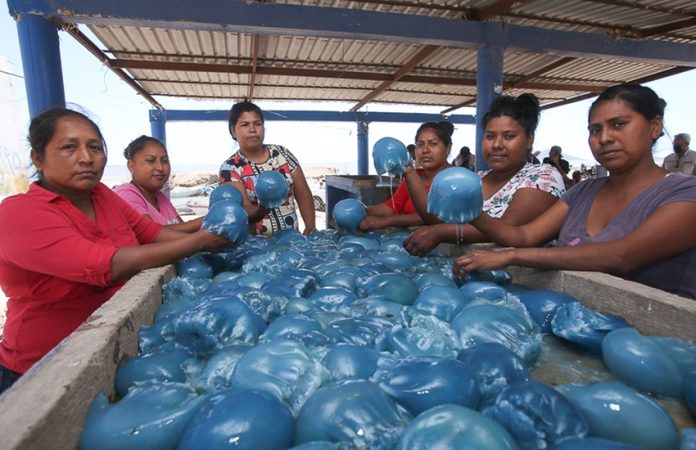It’s May, and that means that Yaqui residents of Guaymas, Sonora, are once again going to sea for their annual jellyfish catch in the Gulf of California.
Since the year 2000, men and women from Yaqui communities in the coastal municipality have been fishing every May for cannonball jellyfish, a species eaten in Asian countries such as China, Japan and Thailand and used in the manufacture of cosmetics and medicines.
One community where many women are involved in the annual jellyfish fishery is Guásimas de Belem, located about 40 kilometers from the city of Guaymas. Residents have had a license to catch cannonball jellyfish, known locally as aguamala, since 2011.
Locals rise early in the morning to go to sea on small fishing boats known as pangas. Catching the jellyfish, an activity that allows many women to achieve economic independence, is simple, according to the newspaper Milenio, requiring only a panga, fuel, a net and a packed lunch to keep hunger at bay.
However, aguamala fishing is also very dangerous. Small pangas are filled with four to six tonnes of jellyfish, which can cause them to tip over or sink.
“It’s risky for a woman, and even more so because they’re not used to doing heavy work,” said fisherman Baldomero González.
One Yaqui woman who has continued to fish for aguamala year after year despite the risks is María Estela Guitimea.
“What are we going to do? That’s life. It’s hard, we have to work. If we don’t fish, there’s no money for frijoles [beans],” she said.
Guitimea goes fishing year-round with her husband, but in May, they focus on catching cannonball jellyfish.
“It’s teamwork: he operates [the boat], and we both fish with nets; I’m at the front, and he’s at the back. … You never know if you’ll make it back [to land]. That’s why I ask God to save me from any problems I might have,” she said.
“One has to earn a living. I like the sea but sometimes the pangas flip over,” she added, saying that she’s more concerned about drowning than being attacked by a marine animal such as a shark.
Once the jellyfish are brought back to Guásimas, they are inspected to make sure that they measure the minimum required length of 11 centimeters. The Yaquis then sell their catch to the Chinese owners of processing plants set up annually in the town. (Three processing plants usually operate in Guásimas, but only one was set up this year because strong winds had a negative impact on the cannonball jellyfish season.)
A kilo of aguamala sells for between 1.8 and 4 pesos (about US $0.10 to $0.20), which doesn’t sound like much but adds up given that each panga brings in daily catches of four to six tonnes.
Yaqui women also earn money preparing the jellyfish for export in the processing plants.
“Our earnings come from the tonnes [of aguamala] we process,” said Jessica Canales, one of the employees.
Nancy García, a single mother, told Milenio that the work she is currently doing at the plant helps her support herself and her two-year-old daughter.
“[The work] helps us because we don’t have to depend on anyone. We are able to give food to our children without needing a man,” she said.
According to the National Aquaculture and Fisheries Commission, more than 12,300 tonnes of cannonball jellyfish were exported from Mexico last year, generating an economic spillover of 30.5 million pesos (US $1.5 million).
Source: Milenio (sp)
